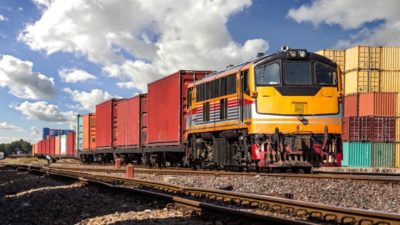The Alberta oil sands contain some 168 billion barrels of oil that can be recovered economically with today’s technology. The problem: actually moving all of that output to market. However, the pipelines needed to transport the province’s growing bitumen production has become a politically heated topic.
In the final installment of my conversation with commodity investor Rick Rule, we discuss:
-
The future of the Keystone XL and Northern Gate pipelines.
-
Is it time to buy the oil sand producers?
-
Why you’re either a contrarian or a victim when it comes to commodity investing.
Below is the transcript of our conversation; it has been lightly edited for clarity.
Robert Baillieul: The real challenge for the energy industry these past few years is actually moving their product to market. There’s a lot of hope riding on the TransCanada (TSX:TRP, NYSE:TRP) Keystone XL or Enbridge (TSX:ENB, NYSE:ENB) Northern Gateway pipelines. Do you see those midstream challenges being alleviated any time soon?
Rick Rule: Yes, I do see them being alleviated but it’s going to be a very long, extensive process.
We are alleviating them now. We have an economically and environmentally superior proposal which is a pipeline. Politically people are opposed to that pipeline. We’re taking a much more distributed, much more expensive, and much more dangerous alternative which is rail cars going forward. In other words, political opposition to the pipelines has lead us to an alternative which is both more expensive and more dangerous.
The [Northern Gateway] pipeline opposition, of course, varies local by local. I would suspect that the opposition, for example, to takeaway capacity from Alberta into British Columbia is really an economic discussion. There are, for example, First Nations groups who have been frozen out of economic participation in the development of their ancestral homelands that would like to get even which is completely understandable. The want some of the benefit of the transmission on their land and they’re using a bunch of arguments to justify their ultimate aim which is a piece of the pie.
In the context of the Keystone [XL] pipeline, the objection in regards to the degradation of the Sandhills of Nebraska is pretty much a strawman. If one really needed to one could divert the pipeline around the sandhills. There is an objection among a certain class of Americans, first of all that hydrocarbon emissions generally, but also to the alleged environmental consequences of heavy oil extraction in Alberta.
If one were to as an example, look at a rational response to those objections, even the greenest of environmentalists want to live the energy intensive lifestyle that they do live, one way that you would suggest that we solve the hydrocarbon emission problem in northern Alberta would be to build nuclear reactors in northern Alberta and use the waste generated heat to steam from those reactors which emit no carbon, in terms of producing two million barrels per day in northern Alberta.
The fact that you would use nuclear power, however, to solve a carbon problem is anathematic to many of the critics of the pipeline who would seem to prefer a luddite alternative as long as it didn’t impact their own lifestyle.
Baillieul: This all sounds very optimistic for the Alberta oil sands. These past few months we’ve seen a lot of money starting to flow into the oil sands. Most noteable Warren Buffett’s $500 million investment in Suncor (TSX:SU, NYSE:SU). Do these midstream developments put the heavy oil names back on your investment radar screen?
Rule: Sure. World economic growth despite alternatives rests on the back of hydrocarbons and as the 3.5 billion people sitting on the bottom of the demographic pyramid begin to get more rich they will begin to compete with you and I for energy. And population growth and human aspiration are increasing much more rapidly than hydrocarbon production.
While access to this crude may be delayed politically for a few years, which certainly for an investment perspective is important in the net present value context, we will find alternatives. We’re building tank cars for railroads to transport crude, dangerous and inefficient as they are, the industry is building those things 24/7. We’ll find a way to get the crude to market because the demand and the margins are there.
Baillieul: One of the issues industry observers are worried about is a looming light oil glut. We have millions of new barrels coming out of these tight shale formations but limited capacity to actually refine it. Are you worried about a light oil glut?
Rule: I think it will be interesting. We, as you point out, have certainly regionally surpluses of light sweet crude. And we have surpluses of hydrocarbon byproducts associated with gas production.
What I think you’re going to see in the United States is a sense that you can export oil in the form of refined products. And you’re seeing as an example right now a great resurgence base chemical production in the United States utilizing our large supplies of liquids, natural gas, and in some cases crude and you have pretty good refining capacity in the United States. You haven’t had a new build in over 30 years but there has been great debottlenecking of refining capacity. What I think what you will see is a increase in oil exports in the form of refined products.
Certainly there will be supply demand imbalances in the three to five year timeframe that while they might not penalize companies too much will present huge opportunity costs for society. We as a society will be incrementally poorer as a result of our political stupidity in terms of using our resources and our refining capacity to the fullest extent that would be possible without political interference. And that’s too bad but it’s a fact.
Baillieul: Rick, we’re coming up on an hour which is all the time I promised to steal from you today. Thank you for taking the time to speak with the Motley Fool community and I. Just as we wrap up, is there anything you would just like to tell our readers.
Rule: In 35 years of doing resource investment to be summarized pretty easily; resource businesses are capital intensive and they’re cyclical. The consequence of that is that to be successful you have to be a contrarian.
When investing in resources you are either a contrarian or you are a victim. Those are the two choices and the choices are yours. When the narrative is overpriced it’s easy to overpay.
When the narrative is underpriced, people around you are feeling negative, despite the fact that the sector has been de risked. So default to the slogan, you’re either a contrarian or you are a victim. The choice is yours.







